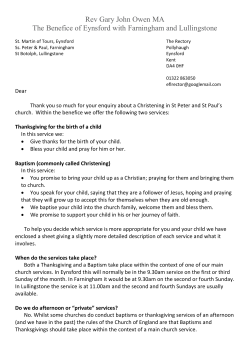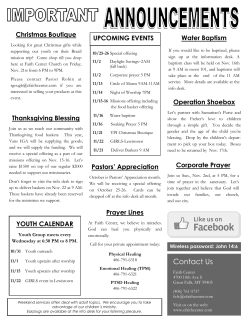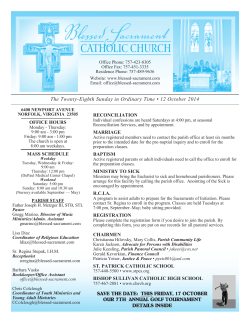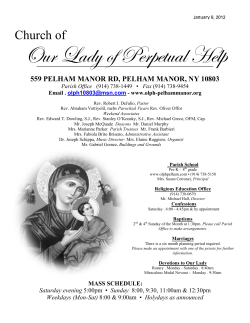
Chapter 1: Baptism
Chapter 1: Baptism THE SACRAMENTS – Source of our Life in Christ 1. Baptism Prefigured in the Old Testament (pp. 26-29) Anticipatory Set In the sacramental life of the Church, there are three Sacraments of Initiation: Baptism, Confirmation, and the Eucharist. These three Sacraments fully incorporate one into the Body of Christ. Identify these three Sacraments from the two quotes from Acts 2 on page 26 of our text. Identify the three over-arching Objectives of this chapter from the paragraph beginning, “Just as it was in the early Church.” 1. Baptism Prefigured in the Old Testament (pp. 26-29) BASIC QUESTION How is the Sacrament of Baptism prefigured in the Old Testament? KEY IDEA Baptism is prefigured in the Old Testament in types such as the Flood, the crossing of the Red Sea, and the crossing of the Jordan River into the Promised Land. In addition, Jewish rites of purification using blood or water also prefigured Baptism. 1. Baptism Prefigured in the Old Testament (pp. 26-29) Why is Baptism the basis and foundation of the Christian life? Through Baptism, the individual receives supernatural life, membership in the family of God, and access to the other Sacraments, especially Confirmation and the Eucharist. What does it mean to prefigure something? It means to show or represent beforehand by a figure or type. What are three Old Testament events that prefigure Baptism? Noah and the flood, the crossing of the Red Sea, and the crossing of the River Jordan into the Promised Land. 1. Baptism Prefigured in the Old Testament (pp. 26-29) Guided Exercise Think/Pair/Share on the following question: Why is water absolutely necessary to life and one of the best gifts that God has given? 1. Baptism Prefigured in the Old Testament (pp. 26-29) How does the story of Noah and the ark prefigure Baptism? God used the Flood to purge the earth of moral evil, just as Baptism washes away Original Sin and personal sin. How is Noah’s ark a “type” or prefigure of the Church? Noah and his family were kept safe within the ark, just as Christians are kept safe within the Church. How does the crossing of the Red Sea prefigure Baptism? Israel escaped slavery and was saved by passing through the waters of the Red Sea while Pharaoh’s wicked forces were destroyed in it. In Baptism, we are freed from the slavery of sin and our former lives and habits are washed away. How did the Chosen People’s crossing the Jordan River also prefigure Baptism? The Hebrews, who wandered in the desert for forty years, crossed the Jordan River and entered into the Promised Land. In the waters of Baptism, the individual passes into the promised land of the Kingdom of God. 1. Baptism Prefigured in the Old Testament (pp. 26-29) What is the origin of the word baptize? The Greek verb baptizein means “to plunge,” “to immerse,” or “to dip.” What is the connection between baptizein and the Hebrew word tabal? In the Septuagint translation of the Old Testament, the Greek baptizein was used to translate the Hebrew word tabal, which was often used to describe various religious rites and actions in which water or blood was sprinkled to purify of uncleanness or deliver from evil. What does it mean to say that water’s use in ritualistic practice allows the symbolic physical action to transcend into metaphysical reality? Because water is used to physically cleanse our bodies, Christ chose water as a symbol of spiritual cleansing. In using the symbolic action of cleansing by water to actually purify a person spiritually, the symbolic action has become a metaphysical, or ‘beyond’ physical, action. 1. Baptism Prefigured in the Old Testament (pp. 26-29) Guided Exercise Work with a partner to identify the solution to each of the following problems to sum up the three examples of Jewish rites of purification. 1. Baptism Prefigured in the Old Testament (pp. 26-29) 1. Baptism Prefigured in the Old Testament (pp. 26-29) Closure Write a paragraph summarizing how Baptism is prefigured in the Old Testament. 1. Baptism Prefigured in the Old Testament (pp. 26-29) Homework Assignment Reading: Pp. 29-33. Questions: Questions: 1-3. Workbook: 1-8. Practical Exercise 1. 1. Baptism Prefigured in the Old Testament (pp. 26-29) Alternative Assessment Free write for five minutes on how God’s use of water for the matter of the Sacrament of Baptism perfectly fits with human nature. 2. The Institution of Baptism (pp. 29-33) Anticipatory Set Incorporate the list of the names of Baptism (found on page 32) into the class’s opening prayer. 2. The Institution of Baptism (pp. 29-33) BASIC QUESTIONS What was the purpose of St. John’s baptism? When did Christ institute the Sacrament of Baptism? What are the main effects of Baptism? KEY IDEAS St. John the Baptist preached a baptism that signified a repentance for the forgiveness of sins. Jesus himself underwent this baptism in order to identify himself with all men. Jesus instituted the Sacrament of Baptism in Galilee after his Resurrection. Baptism frees us of personal and Original Sin and incorporates us into the Body of Christ. 2. The Institution of Baptism (pp. 29-33) What were two daily practices of the Essenes? Daily washings for purification and the wearing of a white garment while they shared a communal meal. What did St. John the Baptist have in common with the Essenes? He lived an ascetic life in the wilderness and administered a baptism for the forgiveness of sins. How did St. John the Baptist describe the difference between his baptism and the Baptism of Christ? St. John said that his baptism was with water for repentance of sins, while the Baptism instituted by Christ would be with the Holy Spirit and fire. Extension: St. John’s baptism did not, in itself, forgive sins, but it was a testimony that the person baptized wanted to be forgiven and purified. 2. The Institution of Baptism (pp. 29-33) Guided Exercise Think/Pair/Share about the first five paragraphs of page 30 (beginning “When St. John the Baptist”) using the following question: Why did Jesus have St. John baptize him? 2. The Institution of Baptism (pp. 29-33) How were the Blood and water that flowed from the side of Christ on the Cross, types of the Sacraments of Eucharist and Baptism? All of the Sacraments gain their powers through the sacrificial Death of Christ on the Cross. When Christ’s side was pierced, Blood and water flowed from the wound. This Blood was literally the Eucharistic Blood that we receive in an unbloody manner at Mass (i.e., under the appearance of wine). The water which flowed from Christ’s side is like the water of Baptism that saves us from spiritual death. Where and when did Christ institute the Sacrament of Baptism? In Galilee, after his Resurrection. What words did Jesus use to institute the Sacrament of Baptism? “Baptiz[e] them in the name of the Father and of the Son and of the Holy Spirit.” 2. The Institution of Baptism (pp. 29-33) Guided Exercise Think/Pair/Share on the following question: What does it mean to say “Baptism is . . . regeneration through water and the word”? 2. The Institution of Baptism (pp. 29-33) What is justification? It is an undeserved gift from God whereby a person is made right with God. What is ex opere operato and how does it apply to Baptism? Ex opere operato means “by the very fact of doing something.” Baptism imprints the soul with a permanent mark or character designating one as a follower of Christ by the very fact of receiving the Sacrament. Why can Baptism be received only once? Baptism makes a permanent change in our souls that nothing can remove or change. Christ instituted the Sacrament of Reconciliation for those sins committed after Baptism. 2. The Institution of Baptism (pp. 29-33) Closure Write a paragraph on the effects of Baptism identified on page 33, putting them in their own words. 2. The Institution of Baptism (pp. 29-33) Homework Assignment Reading: Pp. 34-39 (through “Rite of Baptism”). Questions: Questions: 4-6. Workbook: 9-20. Practical Exercise 2. 2. The Institution of Baptism (pp. 29-33) Alternative Assessment Read the following excerpt from a letter by St. Justin Martyr, written about the year AD 150, to explain Christianity to pagan Romans: "As many as are persuaded and believe that what we [Christians] teach and say is true, and undertake to be able to live accordingly . . . are brought by us where there is water, and are regenerated in the same manner in which we were ourselves regenerated. For, in the name of God, the Father and Lord of the universe, and of our Savior Jesus Christ, and of the Holy Spirit, they then receive the washing with water. For Christ also said, ‘Except you be born again, you shall not enter into the kingdom of heaven’.” According to St. Justin Martyr, how did the early Church practice Baptism? 3. Remission of Sin and Rites of Baptism (pp. 34-40) Anticipatory Set Think/Pair/Write Share on the following prompt: Think of a particular, concrete sin and explain how it violates both love of God and neighbor. 3. Remission of Sin and Rites of Baptism (pp. 34-40) BASIC QUESTIONS What are Original Sin and concupiscence? What are immersion and affusion? What is the form of Baptism in the Latin Rite? How are the Latin and Eastern Rites of Baptism similar? KEY IDEAS Baptism remits Original Sin and grants sanctifying grace, but concupiscence remains, requiring a life of struggle for every Christian. The matter of Baptism is water administered either by immersion (submersion) or affusion (pouring). The form of Baptism in the Latin Rite is “(Name), I baptize you in the name of the Father and of the Son and of the Holy Spirit.” While Baptism can be administered in a very simple form, both the Latin and Eastern Rites have very beautiful and rich liturgies for celebrating Baptism. 3. Remission of Sin and Rites of Baptism (pp. 34-40) What is sin? It is any chosen action by which a person effectively places his or her own will before the will of God. What is the distinction between mortal and venial sin? Mortal sin breaks our friendship with God, while venial sin damages it. What is concupiscence? It is the attraction to sin that remains in us, even after Baptism. What is the first, or Original, Sin? Adam and Eve’s disobedience by eating the forbidden fruit. 3. Remission of Sin and Rites of Baptism (pp. 34-40) What did Original Sin introduce into the world? Loss of Paradise, the tendency to sin (concupiscence), and suffering and death. What does it mean to be born into a fallen state? It means having lost the grace of original holiness (and original justice) and friendship with God. It means we need saving grace. How do we receive the benefit of the forgiveness of sins (Original and actual), which Christ won on the Cross? In the Sacrament of Baptism. 3. Remission of Sin and Rites of Baptism (pp. 34-40) Guided Exercise Complete a focused reading on the final two paragraphs of page 34 (“While Baptism,” and “Baptism initiates”) using the following question: How does concupiscence affect the life of every Christian? 3. Remission of Sin and Rites of Baptism (pp. 34-40) What are the two basic forms of applying the matter (i.e., the water) of the Sacrament of Baptism? Describe each. Immersion is the complete submersion of a person in water. Affusion is the pouring of water on the person. What is good about the reemergence of the practice of Baptism by immersion in the Western Church? Going under the water symbolizes our burial into Christ’s Death. Emerging from it symbolizes our rising into new life. 3. Remission of Sin and Rites of Baptism (pp. 34-40) What is the form of Baptism in the Latin Rite? “(Name), I baptize you in the name of the Father and of the Son and of the Holy Spirit.” Who is the ordinary minister of Baptism? A bishop, priest, or deacon. Who can administer Baptism in case of emergency? Any person, even a non-baptized one. 3. Remission of Sin and Rites of Baptism (pp. 34-40) Why are the baptized given a saint’s name? The baptized person is named after one of the many heroes among Christ’s followers to help inspire him or her in the Christian Life. What responsibilities do the parents of the baptized infant freely accept? They agree to train the child in the practice of the Faith and teach the child to keep the Commandments. Why is the Christian home a domestic church? The parents have the primary role of teaching, governing, and sanctifying their children. What should be done in a situation where there is no hope that the child will be brought up in the Catholic Faith? Baptism should be delayed. 3. Remission of Sin and Rites of Baptism (pp. 34-40) What is the role of the godparents or sponsors? They help the child learn to live a Christian life. Why can a non-Christian not be a godparent? A godparent promises to help raise the child in the Faith. Extension: One cannot be expected to give what one does not possess. What are the major sections of the Baptismal liturgy? Sign of the Cross Reading of the Word of God and a homily Litany of the saints Anointing with the Oil of Catechumens Renewal of baptismal promises The Baptism proper Anointing with Holy Chrism Clothing the child in a white garment and giving the child a lighted candle The Lord’s Prayer Blessing for the father, the mother and everyone else present 3. Remission of Sin and Rites of Baptism (pp. 34-40) Guided Exercise Read “Eastern Rite Baptismal Ceremony” and identify differences between Baptisms in the Eastern and Latin Rite. 3. Remission of Sin and Rites of Baptism (pp. 34-40) Closure Write down how you would go about baptizing a person who requested it and was in danger of death. 3. Remission of Sin and Rites of Baptism (pp. 34-40) Homework Assignment Reading: Pp. 40-43. Questions: Questions: 7-28. Workbook: 21-39. 3. Remission of Sin and Rites of Baptism (pp. 34-40) Alternative Assessment How would life be different if Baptism removed every inclination to sin? 4. Baptism – Final Considerations (pp. 40-44) Anticipatory Set Class discussion on Practical Exercise 3, regarding whether a person who has tried to live a good life by following his conscience and searching for the truth can get into Heaven without receiving sacramental Baptism. 4. Baptism – Final Considerations (pp. 40-44) BASIC QUESTIONS What vocation does each Christian share? Why is Baptism a Sacrament of faith? Is infant Baptism licit? Is Baptism necessary for salvation? KEY IDEAS Baptism calls each person to live out the priestly, prophetic, and royal mission of Christ. One must explicitly or implicitly have faith to be baptized. Infant Baptism is in accord with reason and Church history. Properly understood, one must be baptized in order to be saved. However, God provides a means of salvation for those who cannot be baptized with water: this includes Baptism of Blood and Baptism of Desire. 4. Baptism – Final Considerations (pp. 40-44) What is the basic vocation of every Christian? Each shares in the priestly, prophetic, and royal mission of Christ and, thus, builds up the Church. What is the catechumenate? It is a period of prayer, reflection, and instruction in which an adult candidate prepares for Baptism. What does it mean to say that Baptism is a Sacrament of Faith? It means that one must have an active faith in God as revealed by Jesus Christ and must have the intention of receiving the benefits and graces promised by the Sacrament. 4. Baptism – Final Considerations (pp. 40-44) In the case of children not capable of explicitly expressing their faith or of requesting Baptism, who makes the Profession of Faith? The parents and godparents make it in the child’s name. What is required for a child whose parents make the profession of faith for him or her? Several years of post-Baptismal instruction. 4. Baptism – Final Considerations (pp. 40-44) Who can be baptized? Any person who believes and requests the Sacrament can receive it. How old is the practice of infant Baptism? It probably goes back to the very beginning of the Church when the Apostles baptized whole households. The Church fathers speak of infant Baptism as early as the second century. Why does infant Baptism accord with reason? Parents have the right and the obligation to make all kinds of decisions for their children’s future. The best thing they can do for their children is to have them baptized and then raised in the Catholic Faith. 4. Baptism – Final Considerations (pp. 40-44) Is infant Baptism an imposition on the child’s freedom? No. The child will have to decide for him or herself, when he or she reaches maturity, whether to live the Faith or not. How does infant Baptism contribute to the spiritual growth of the family? Because of the responsibilities the Christian parents undertake, they are motivated to live a more profound Christian life. 4. Baptism – Final Considerations (pp. 40-44) What does the Church mean when it teaches that Baptism is necessary to be saved? It means that those who have heard the Gospel and who have had the opportunity to ask for it must be baptized in order to be saved. Why is it not unreasonable to require Baptism for those who have heard the Gospel and understand that it is necessary for salvation? Because Baptism is the means Christ has established and the Church in obedience cannot teach differently. What does it mean that the Church is bound to the Sacraments but God is not? While an individual should seek God’s grace in the way and in the manner that Christ instructed, God can choose any means he wishes to convey his grace in accordance with his divine wisdom. 4. Baptism – Final Considerations (pp. 40-44) Guided Exercise Complete the following table to see the different situations in which a non-baptized person can be saved. 4. Baptism – Final Considerations (pp. 40-44) 4. Baptism – Final Considerations (pp. 40-44) Guided Exercise Discuss the following question, and assemble a number of arguments for the Church’s on-going missionary efforts: Given that God provides actual graces to non-Christians and ways for them to be saved, what is the point of the Church’s missionary efforts? Wouldn’t it be better to just leave people alone? 4. Baptism – Final Considerations (pp. 40-44) Closure Free write for five minutes articulating reasons regarding the benefits of infant Baptism. 4. Baptism – Final Considerations (pp. 40-44) Homework Assignment Reading: Pp. 44-45. Questions: Questions: 29-44. Workbook: 40-48. Practical Exercises 3 & 4. 4. Baptism – Final Considerations (pp. 40-44) Alternative Assessment Write a paragraph on what the Church teaches about the necessity of Baptism and how those who have not been baptized can be saved by Christ. THE END
© Copyright 2025









